Are you a Quiet Speculation member?
If not, now is a perfect time to join up! Our powerful tools, breaking-news analysis, and exclusive Discord channel will make sure you stay up to date and ahead of the curve.
Every time spoiler season rolls around, I eagerly pore over the commons, searching for Modern-playable... Rogues. Everyone has their guilty pleasures, their sick addictions. When it comes to Modern, mine is the interaction between tribal spells and Tarmogoyf. And my favorite tribal spell? A one-mana Impulse called Thieves' Fortune.
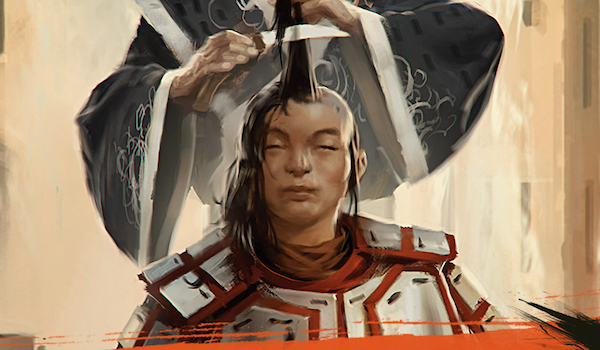
Just as Ancient Stirrings, powerful as it may be, isn't quite a one-mana Impulse, neither is Thieves' Fortune. These cards must be played in very specific shells to shine brightest. Of course, one is leagues more splashable than the other. But that won't keep me from fighting!
This article revisits my Vial Rogues deck and explores the viability of nerfed Splinter Twin strategies in Modern.
[wp_ad_camp_1]
Remembering Splinter Twin
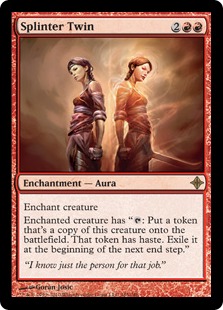 Gee, what a deck that was. Twin sat atop Modern as of the format's inaugural Pro Tour and remained a major Tier 1 contender throughout its entire life. Then, finally, it was infamously given the axe on the eve of Eldrazi Winter.
Gee, what a deck that was. Twin sat atop Modern as of the format's inaugural Pro Tour and remained a major Tier 1 contender throughout its entire life. Then, finally, it was infamously given the axe on the eve of Eldrazi Winter.
Interactive Combo in Modern
Post-ban, I held the controversial opinion that Twin was in fact too strong for Modern, finding the tournament data in line with both Wizards' historical banlist policy and their official announcement. I also proposed a theory that Twin was too strong for Modern on a fundamental level, called "Turn Four Rule Abuse:"
While Modern has a turn four rule that Twin didn’t violate, I think an interactive deck of its dexterity has no real business winning that quickly. Splinter Twin doesn’t exemplify Modern’s turn four rule—it abuses it. (...)
It doesn’t make sense from a format-design standpoint to have a deck like Splinter Twin exist, because it becomes incorrect to play a dedicated combo deck with the same turn four restriction. Twin “goes off” by the same time, but doesn’t fold to hate, has mana to interact early in the game instead of setting up an elaborate combo kill, and polices Modern’s faster linear decks.
What we've seen since the Twin ban is that most interactive combo shells are simply too slow for Modern. As of last week's Nexus update, Temur Scapeshift has all but disappeared from the metagame, leaving only Valakut combo decks to cheese victories on turns five and six. Those decks win a turn earlier than Remand-featuring Scapeshift variants, and boil their interaction suite down to the bare necessities—in other words, Anger of the Gods.
Another factor keeping Valakut above water is its Plan B. The deck can survive having its Primeval Titans Thoughtseized away by simply making land drops and doming with its namesake land. Setting the stage for today's interactive combo decks, Twin was the king of Plan B, riding humble beats from Snapcaster Mage, Pestermite, and Deceiver Exarch to victory as often as it cloned a million Clerics.
Twin's Role in the Deck
An important point to remember when discussing Twin strategies is why they employ Splinter Twin effects in the first place. Playing fair will only get you so far in Modern. You might break up enough synergy and produce enough pressure to win a match, and many decks do (well, Jund does). But some decks will out-grind you. Any Jund pilot will tell you Tron is close to unbeatable for fair midrange decks.
Splinter Twin gave blue midrange decks an easy out to these "go bigger" strategies by ignoring their late game entirely. Any opponent who managed to render the ol' Bolt-Snap-Bolt irrelevant still had to worry about an entirely separate angle of attack.
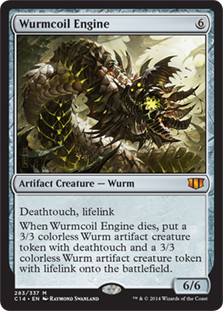 In practice, Twin kind of plays the same role in blue midrange decks as reach plays in tempo strategies. These low-to-the-ground aggro-control decks try to frontload as much damage as they can with efficient attackers, but well-equipped opponents often manage to stabilize the board eventually. Once that happens, the tempo deck can play to the top of its library, hopefully drawing enough Lightning Bolts to kill opponents outside of combat.
In practice, Twin kind of plays the same role in blue midrange decks as reach plays in tempo strategies. These low-to-the-ground aggro-control decks try to frontload as much damage as they can with efficient attackers, but well-equipped opponents often manage to stabilize the board eventually. Once that happens, the tempo deck can play to the top of its library, hopefully drawing enough Lightning Bolts to kill opponents outside of combat.
The Twin combo negates the kind of stabilization that reach doesn't hold a candle to, like two hits from Wurmcoil Engine, a Leyline of Sanctity, or infinite life. But it requires deckbuilders to play with expensive cards—Delver of Secrets and Boros Charm are a lot cheaper to cast than Pestermite and Splinter Twin. This restraint wasn't an issue while Twin was legal, but the Boltable, five-mana Kiki-Jiki is another story.
One Ugly Goblin
Kiki-Jiki, Mirror Breaker worsens Twin in a number of ways. For one, he makes it impossible for the deck to abuse the turn-four rule. Second, his high cost makes him more difficult to cast for value with cards like Snapcaster Mage, Spellskite, and Humble Defector. That cost also makes drawing multiple copies clunkier, encouraging us to find ways to play less than four. Finally, Kiki-Jiki's triple-red color requirement contorts the manabase in a way that limits our utility land options, forcing a mostly blue deck to play an uncomfortable amount of red lands.
All these problems have kept Twin decks from seeing virtually any play since the ban. But the Goblin does have some marginal upsides. Gone are the days of getting two-for-one'd by a Terminate, for instance, and Kiki-Jiki can be played for zero mana off an Aether Vial or searched up with Traverse the Ulvenwald.
Going Rogue
The Temur Twin variant doubled down on Twin's combat plan by including Tarmogoyf, Modern's most efficient combat creature. Vial Rogues upholds the tradition of turning dudes sideways and only going off when it has to.
Vial Rogues, by Jordan Boisvert
Skewing the Bolt Test... Again
In a comment on my article from last week, one reader wondered if I give Lightning Bolt too much credit. But I honestly believe it's impossible to overstate the card's relevance. Modern is such a tempo-centric format that giving close to half of your potential opponents the option to gain mana by removing your creatures (something they were going to do anyway) is tantamount to suicide. Yes, losing a three-mana creature to a one-mana spell is really that bad!
This proclamation begs the question: why are we playing Humble Defector and Pestermite? Vial Rogues has a number of ways to skew the Bolt Test in its favor and accommodate these apparently unplayable creatures.
- Mana dorks. At one mana, Noble Hierarch passes Sheridan's refined Bolt Test with flying colors. Modern players know by now to always Bolt that turn-one dork. When opponents have the instant and we open Hierarch, she basically doubles as Thoughtseize. If they don't, she doubles as Time Walk.
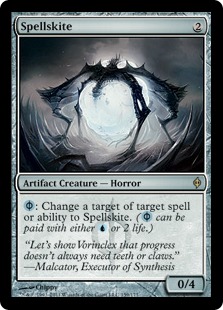 Spellskite. Spellskite hoses a few archetypes on his own (Infect, Death's Shadow Zoo, Bogles), but I prefer to use the Horror as a Chalice of the Void for Lightning Bolt. Having Skite on the table prevents opponents from zapping anything else, and the card requires two Bolts from decks without any heavy-duty removal. Many Bolt decks rely on Path to Exile to remove big-booty creatures, in which case Skite doubles as Thoughtseize plus Rampant Growth.
Spellskite. Spellskite hoses a few archetypes on his own (Infect, Death's Shadow Zoo, Bogles), but I prefer to use the Horror as a Chalice of the Void for Lightning Bolt. Having Skite on the table prevents opponents from zapping anything else, and the card requires two Bolts from decks without any heavy-duty removal. Many Bolt decks rely on Path to Exile to remove big-booty creatures, in which case Skite doubles as Thoughtseize plus Rampant Growth.
- Tarmogoyf/Traverse the Ulvenwald. I've long called Goyf a mana dork's dream funeral procession, emerging as a functional Eldrazi after Birds bite the dust. But Tarmogoyf's breakfast doesn't have to be a mana dork. He's happy to chew on any x/1. Traverse the Ulvenwald is a natural compliment to the beater, benefitting from the same conditions (interactive Magic, mana dorks dying, etc.) and even searching for Tarmogoyf when his bulk is required. In a deck with so many fetchlands, instants, and sorceries, achieving delirium is often trivial should Humble Defector goes all Benjamin Franklin on us.
- Aether Vial: Over the course of a six-turn game, one Aether Vial can theoretically provide us with up to 15 mana. I'll admit that I've never seen that happen, but Vial does make heaps of mana in this deck, especially when accounting for Humble-Mite-Snap-Snag shenanigans. Three-mana creatures suddenly don't seem so bad when they realistically cost no mana to summon.
Explaining the Boltables
Why are we skewing the Bolt test again? Oh yeah, so we can play the following terrible creatures, ahem, I mean, Rogues.
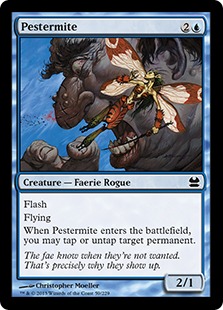 Pestermite: Thanks to stupid Kiki-Jiki, our combo can be Bolted by default, making Pestermite more or less strictly better than Deceiver Exarch. She hits twice as hard and becomes a Vendilion Clique with Noble Hierarch in play. Mite's evasion has additional synergy with Tarmogoyf, since she can poke in the air while the jolly green giant holds down the ground.
Pestermite: Thanks to stupid Kiki-Jiki, our combo can be Bolted by default, making Pestermite more or less strictly better than Deceiver Exarch. She hits twice as hard and becomes a Vendilion Clique with Noble Hierarch in play. Mite's evasion has additional synergy with Tarmogoyf, since she can poke in the air while the jolly green giant holds down the ground.
- Humble Defector: Passing this guy back and forth across the table is about as surreal as it is thrilling. Humble has a ton of micro-synergies in this deck. We can pseudo-blink him with Pestermite to draw four cards before shipping him, bounce him back to our own hand with Vapor Snag for a +1 and one damage, or copy him with Kiki-Jiki to draw two cards each turn when that matters (okay, never). Defector also allows us to load up on Snags, since his ability is incidentally most relevant in matchups that don't care about a bounce spell.
Considering Consistency
In my theory on metagame parameters, I outlined three key components of successful decks: proactivity, interactivity, and consistency. The latter is probably my favorite—as someone who brews obsessively, it's important to me that my decks actually do what I want them to with great frequency. This bias gives me an unconditional love of cantrips.
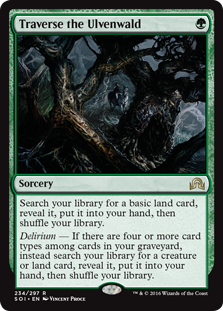 Serum Visions is the obvious cantrip in this kind of shell, but Traverse the Ulvenwald is our most important. Once delirium has turned on, we get to play an entirely different game, fetching up a stream of Lhurgoyfs or comboing off as needed. In the meantime, Traverse's Lay of the Land mode helps with Kiki-Jiki's high mana cost, casting Blood Moon on time, and ensuring we make our land drops against speedy linear decks.
Serum Visions is the obvious cantrip in this kind of shell, but Traverse the Ulvenwald is our most important. Once delirium has turned on, we get to play an entirely different game, fetching up a stream of Lhurgoyfs or comboing off as needed. In the meantime, Traverse's Lay of the Land mode helps with Kiki-Jiki's high mana cost, casting Blood Moon on time, and ensuring we make our land drops against speedy linear decks.
I'd be remiss to omit Thieves' Fortune from this section, as it's the reason we play any Rogues at all. Fortune has a few benefits over the other cantrips to justify its high cost. It grows Tarmogoyf at instant speed, allows us to hold up mana and pass the turn, and can sometimes be cast as an upgraded Impulse. I'm down to just two copies, but so far I still like those enough not to scrap this deck entirely.
While cantripping is one way to ensure consistency, starting at the deckbuilding level is another option. Full sets of Noble Hierarch and Aether Vial maximize our quick starts, creating consistency by redundancy. Between hands with one of these eight mana accelerators and hands featuring Bolt-Serum-Goyf, Vial Rogues boasts plenty of competent openers.
Going Over Board
As with many of my brews, the sideboard is integral to the deck's success.
- Anger of the Gods: In such a fast format, Anger kills pretty much every creature in any turn-four aggro deck. It also grants us major points against Dredge, slowing them down enough for us to steal a win with Tarmogoyf or Kiki-Jiki, and Hierarch decks in general. Sure, we run Hierarchs of our own, but I think it's wrong for any interactive deck that can reliably hit double red by turn three to omit this card from its 75. It just does too much.
- Blood Moon: My initial arguments for Traverse the Ulvenwald featured Magus of the Moon, who I figured would be immensely powerful as a searchable copy of the enchantment. In many Moon matchups, though, dying to Bolt is highly relevant. In others, we don't want to set up delirium, cast Traverse, and play the Moon on turn four or later, when it might be too late. Decks like Tron make it tough for us to achieve delirium in the first place since they don't kill our threats. All these factors led me to want enough copies of Blood Moon to find it consistently without doing much work.
 Remand: I think Remand is a horrible card in Modern. Ever since the Twin ban, this card's stock has gone down the drain. Rare are the times we can Remand our own spell in response to an opponent's counterspell, and Remand does practically nothing against low-to-the-ground strategies like Affinity and Burn. But the card does shine in certain matchups, especially in those which we want Kiki-Jiki for. Much of our removal is lackluster there, so Remand can come in for it and give us extra points.
Remand: I think Remand is a horrible card in Modern. Ever since the Twin ban, this card's stock has gone down the drain. Rare are the times we can Remand our own spell in response to an opponent's counterspell, and Remand does practically nothing against low-to-the-ground strategies like Affinity and Burn. But the card does shine in certain matchups, especially in those which we want Kiki-Jiki for. Much of our removal is lackluster there, so Remand can come in for it and give us extra points.
- Ancient Grudge/Reclamation Sage: Grudge is just the nut in Modern. And hey, sometimes you have to out a Worship.
- Stormbreath Dragon: A lot of decks just can't deal with this card. Jeskai and anything Abzan-colored have a terrible time removing the Dragon, which kills them in a few hits. After Kiki-Jiki, Tarmogoyf, and Moon, Stormbreath gives us a fourth angle of attack against grindy value-based decks like Abzan Company.
Long Hard Rogue
I know this deck has its faults. It's a Humble Defector deck, after all. But the beauty of Modern is that players can sleeve up whatever they like and have a good time. Temur Rogue shells are something I've worked on for years and will continue to tweak as Wizards gradually releases more of the snubbed tribe into Modern. It's only a matter of time until we get a Modern-playable creature that's also a Rogue. And then this deck will lose a little less.
Vial Rogues probably isn't even the best Kiki-Mite deck in Modern (an honor that regretfully might go to the Eldritch Evolution builds cropping up here and there). But either way, it gives me something extra to look forward to every three months: the Rogues each set has to offer. Given the format's protean nature, Modern has sublime pleasures like these to offer players with any preoccupation. Who knows? Maybe your own wacky brew is just an Amonkhet uncommon away from playability.




I used to snub tribal decks because i though they were too boring and obvious to build (sorry merfolks). Just play a bunch of lords and fill the rest with the best there is of tribe x-y-z… But fortunately wizards have improved the subtlety of tribal interactions in the most recent blocks. Now my two favorite modern decks are spirits and zombies! I only play one lord in spirits (the only one there is…) and none in zombies, and all the synergies are tricky and interesting. I feel both decks are just one or two playables away from being complete… And they are not the most uncommon creature types!
Rogues is another interesting tribe, building around thieves’ fortune is a lot more fun than around the black rogues from lorwyn/etc. It is always exciting to have one or more brews on hold, makes spoilers more thrilling! For my part i’m crossing my fingers also for artificers/vedalken in the upcoming set, so that i can use my cavern of souls in yet another deck 😛
This is neat in that you just incidentally get to run thieves fortune and get some goyf value for your trouble. Defector and mite do work together and both have kiki tricks. Snag is good with vial as it can save you needing to recast and wait for summoning sickness. Im skeptical of traverse as there is so little versatility – you are getting goyf like 90 percent of the time and kiki the other ten? Tutoring like that seems a bit like a waste, at least add some other niche target to the md to steal games.
All in all looks cool tho – how does defector play out? It seems rattlesnakish where you mostly leave him untapped to punish attacks or respond to removal and then go to valuetown once you have room to snag or pester? Id be iffy about swinging for prowl with him unless I could flash in pester to respond to removal.
Also generally for kiki twin we just moved on to resto angel as the other piece instead of pester or exarch. It wouldnt work with twin but once you’re stuck with kiki angel is a much better card in a vaccum than the blue options.
I think Traverse is necessary in this kind of shell because it gives us on-demand access to Kiki-Jiki. Otherwise, the Kiki-Mite combo doesn’t really work, since we’d be forced to run multiple copies of the Kiki (bad for the reasons listed above) and more lands (same). And unfortunately, I think including the combo is where the Vial Rogues deck wants to be.
Defector is great fun more than anything else. Opponents frequently get more mileage out of two of their own cards than out of a 2/1 beater, so must will just activate him and pass him back. It’s rare that they have ways to remove him after that since they want to blow their Bolts on Pestermite or Hierarch or something, so they need to draw into another one and then want to kill Defector. Add to that the fact that we rarely pass Defector without squeezing extra value out of him (i.e. untapping with a Pestermite, Snagging him after drawing two) and he’s putting in a lot more work for us than for them. Defector also swings fairly often in this deck. Against anyone without blockers (AN, Tron, Valakut, Jeskai, etc.), we often want to attack with Defector at least until we can combo him with something, so he turns on prowl quite a bit.
I’m not saying this is the best pseudo-Twin deck in Modern, just that it’s probably one of the more reasonable ways to build around Thieves’ Fortune.
Francis,
You’re playing Zombies in Modern? I’m very curious, as I’ve wanted to try that but haven’t figured it out. Have a list, or even just a general description? Thanks!
Sure, but keep in mind i have only played more of less 15 matches with it so far (and doing fine):
Sorceries: 12
4 inquisition of kozilek
4 dark salvation
4 collective brutality
creatures: 26
4 cryptbreaker
4 gravecrawler
4 blood scrivener
4 rotting rats
4 diregraf colossus
2 fleshbag marauder
2 Kalitas, traitor of ghet
2 vengeful pharaoh
lands: 22
15 swamp
1 urborg, tomb of yawgmoth
1 shizo, death’s storehouse
1 cavern of souls
2 mutavault
2 tectonic edge
sideboard:
1 duress
2 wail of the nim
2 crypt incursion
2 pithing needle
2 ratchet bomb
2 big game hunter
4 stromgald crusader
So the deck is basically disruption (discard + removal) and threats (tokens and big guys). It is very midrangey and kind of slow but full of value!
Formats that already have hugely powerful cards (i.e. Legacy with Brainstorm, Modern with Lightning Bolt) rarely receive much in the way of straight goodstuff, since those cards usually have to go through Standard first (True-Name Nemesis etc. are the obvious exceptions, although they don’t apply to Modern). That means the longstanding format strategies that receive the most support from Wizards are synergy-based.
There was a time in Modern where running synergy decks was suicide, as Jund and Twin kept everything in check. As more support is printed for synergy strategies, though, we inevitably start to see many crop up (Bant Spirits or Elves, for example).
Luckily for goodstuff decks, the playability bar for synergy strategies is set very high by interactive helpers like Tarmogoyf! Those new Sprits have to be pretty good to justify playing cards like Geist or Rattlechains over a 4/5 who asks you to run Lighting Bolt (according to last weekend’s SCG Classic results, the Spirits do indeed have what it takes). That’s why we don’t see tribal strategies leak into Modern at breakneck speed. We’ll have to wait a little longer before Rogues become a viable option.
I’ve been toying around with a rogues deck. It’s probably not that great but there’s an interaction I quite like
Grixis thieves
2x thoughtseize
2x inquisition of kozilek
4x lightning bolt
4x thieves fortune
4x faerie miscreant
2x snapcaster mage
4x oona’s prowler
1x cloak and dagger
2x earwig squad
4x spellstutter sprite
1x quickling
1x sword of light and shadow
2x kolaghan’s command
1x vendilion clique
2x notion thief
2x noggin whack
21 lands
4x polluted delta
2x bloodstained mire
1x faerie conclave
4x secluded glen
1x mutavault
1x blood crypt
1x watery grave
1x steam vents
2 island
1 swamp
1 mountain
1x darkslick shores
1x creeping tar pit
Sideboard:
2x earwig squad
1x Knowledge exploitation
1x gonti, lord of luxury
2x faerie macabre
2x spell pierce
2x Fortune thief
1x Nezumi shortfang
2x crumble to dust
Flex slots
The notable interaction is notion thief+humble defector
And quickling+defector
Both those cards do lots of other things but I just thought it was worth noting and a suggestion